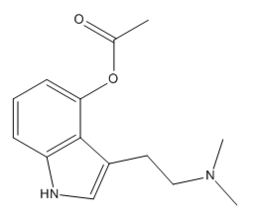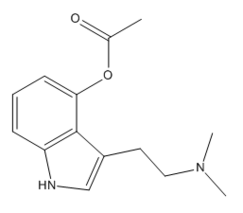4-AcO-DMT: Difference between revisions
>Oskykins No edit summary |
>Josikins m 1 revision |
(No difference)
| |
Revision as of 21:07, 23 February 2014
Psilacetin (also known as O-Acetylpsilocin, 4-Acetoxy-DMT, or 4-AcO-DMT) is a synthetically produced psychoactive drug and has been suggested by David Nichols to be a potentially useful alternative to psilocybin for pharmacological studies, as they are both believed to be prodrugs of psilocin. However, many report that psilocetin's effects differ greatly from that of psilocybin and psilocin.
Chemistry


Psilocetin is made up of a tryptamine backbone with an acetoxy group attached to carbon R4 of the indole ring, and two methyl groups substituted onto the nitrogen RN1 and RN2.
Pharmacology
Psilocetin acts as a 5-HT2A, 5-HT2C and 5-HT1A partial agonist; the psychedelic effects are believed to come from psilocetin's efficacy at the 5-HT2A receptors. At high doses, there is some efficacy to noradrenaline receptors.
Subjective effects
The physical effects of Psilocetin can be broken down into five components all of which progressively intensify proportional to dosage.
- Spontaneous tactile sensations - the body high of Psilocetin can be described as a pleasurable, warm, soft and all encompassing tingling sensation. This maintains a consistent presence that steadily rises with the onset and hits its limit once the peak has been reached.
- Sedation - in terms of its effects on the physical energy levels of the tripper Psilocetin is considered by most to be relaxing, stoning and mildly sedating. This sense of sedation is accompanied by compulsive yawning, a runny nose and watering eyes.
The head space of Psilocetin is described by many as extremely relaxing, profound and stoning in its style when compared to other commonly used psychedelics such as LSD or 2C-B which tend to be energetic and stimulating. It contains a large number of psychedelic typical and unique cognitive effects.
The most prominent of these typical effects include:
- Introspection
- Connectivity of thought
- Outrospection - can be described as states of contemplation which feel almost forcibly directed towards contemplating the society we live in, the nature of existence, our place in the universe and other general philosophical thoughts.
- Enhancement of current mind state
- Removal of cultural filter
- Feelings of fascination, importance and awe
- Conceptual thinking
- Direct communication with the subconscious
- Ego suppression, loss and death
- Time distortion
- Deja-vu
- States of unity and interconnectedness
The most commonly reported unique cognitive effects include:
- Cognitive enhancement and suppression cycles - Can be described as constant waves of extremely stimulated and profound thinking which are spontaneously surpassed cyclic by waves of general thought suppression and mental intoxication. These two states seem to switch between each other in a consistent loop once every 20 - 60 minutes.
Psilocetin presents a full and complete array of possible visual enhancements which generally includes:
As for visual distortions and alterations, effects experienced are detailed below:
- Drifting (Melting, Flowing, Breathing and morphing) - in comparison to other psychedelics this effect can be described as highly detailed, slow and smooth in motion and static in their appearance.
- Tracers
- After images
- Texture repetition
- Colour shifting
- Scenery slicing
The visual geometry that is present throughout this trip can be described as more similar in appearance to that of 4-AcO-DMT, Ayahuasca and 2C-E than LSD. They can be comprehensively described as structured in their organization, organic in geometric style, intricate in complexity, large in size, fast and smooth in motion, colourful in scheme, glossy in colour, blurred in their edges and rounded in their corners. They have a very "natural" feel to them and at higher dosages are significantly more likely to result in states of Level 7B visual geometry over Level 7A.
Psilocetin and its various other forms produce a full range of high level hallucinatory states in a fashion that is more consistent and reproducible than that of many other commonly used psychedelics. These effects include:
- Imagery - in comparison to other psychedelics such as LSD, Psilocetin is extremely high in imagery embedded within visual geometry.
- Transformations
- Breakthroughs - this particular effect commonly contains hallucinations with scenarios, settings, concepts and autonomous entity contact. They are more common within dark environments and can be described as internal in their manifestation, lucid in believability, interactive in style and almost exclusively of religious, spiritual, mystical or a transcendental nature in their overall theme.
The auditory effects of Psilocetin are common in their occurrence and exhibit a full range of effects which commonly includes:
Toxicity and Harm Potential
Lethal Dosage
The LD50 of psilocetin has been extrapolated from animal results to 800mg for an average human.
Tolerance and Addiction Potential
Psilocetin tolerance lasts for approximately a week, meaning that it is very difficult to form an addiction to this substance. It also has a high cross-tolerance, affecting the potency of other tryptamines.
Legal Issues
Possession and sale of psilocetin is unscheduled in most countries.
- UK: Could be considered illegal under the 1971 Misuse of Drugs Act as it metabolises into psilocin.
- USA: Could be considered illegal under the Federal Analog Act as an analogue of psilocin.
